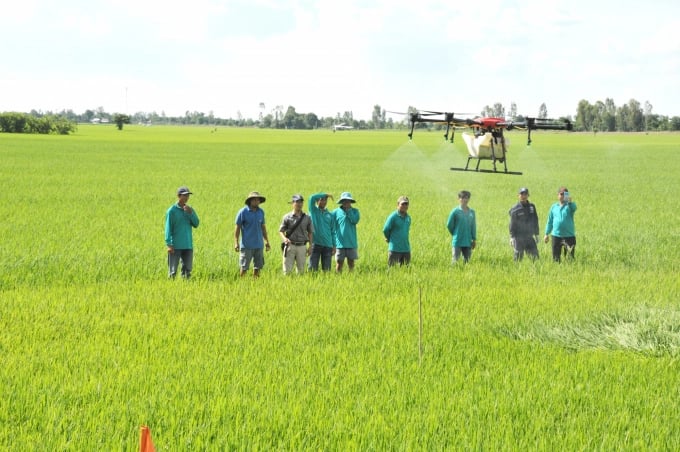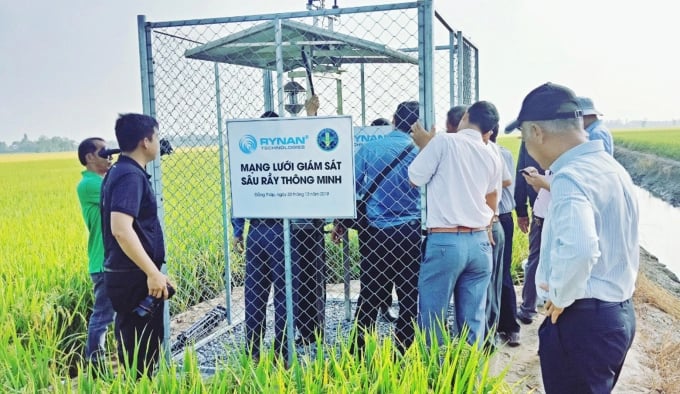May 28, 2025 | 07:42 GMT +7
May 28, 2025 | 07:42 GMT +7
Hotline: 0913.378.918
May 28, 2025 | 07:42 GMT +7
Hotline: 0913.378.918
In this autumn-winter crop, My Thanh Bac cooperative (My Thanh Bac commune, Cai Lay district, Tien Giang province) partnered with farmers to apply high technology in rice production with a scale of 200 hectares. Accordingly, 40% of materials such as seeds, fertilizers, and Trichoderma fungi were supported by the government. The smart fertilization and mechanical transplanting of rice were applied for demonstration in 13 hectares. The automatic irrigation system controlled by smartphones will be demonstrated in the next winter-spring crop.

Drones for spraying plant protection drugs were used in summer-autumn crop in My Dong 2 ( Thap Muoi, Dong Thap). Photo: Le Hoang Vu.
Mr. Nguyen Van Viet, Director of My Thanh Bac Agricultural Cooperative, said: The first method of high-tech rice cultivation is sparse sowing then using buried fertilizers twice per crop: Fertilizing for the first time before sowing, then till the soil and sowing. Buried fertilizer is suitable for spring crops with sunny weather, the rice plants are well-absorbed, however, if it rains, around 40 -50% amount of fertilizer will be lost (applying 25kg per hectare for the first fertilization is recommended).
However, due to the poor manure retention of soil in this crop, it is recommended to use 15 kg of fertilizer per hectare in the first fertilization, and the rest should be applied after 18 – 20 days. The second fertilization should be done at the panicle initiation stage. The fertilization should be done twice in the winter-spring crop, and 3 times in the summer-autumn and autumn-winter crops, which can help to reduce the farmer’s labor. Fertilization can be done once or twice, depends on each crop, instead of 4 times as using the previous technique, therefore the workdays can be saved. The cooperative applies the cultivation process namely "3 decreases and 3 increases” combined with regular field visits so that when the rice is affected by diseases or insects, the farmers can timely handle it.
“We have implemented the pilot model on 13 hectares invested by the Government with a sowing system, transplanters, and 1,000 seedling trays, which cost 630 million VND. In addition, a smart automatic irrigation system controlled by smartphones has also been developed. We also have water level monitors installed on the field to control water supply and pumping. The total value of the investment for this model is over 1 billion VND”, said Mr. Viet.
Members of the cooperative have been trained on "3 decreases, 3 increases" (Decrease the amount of seeds sowing, Decrease the amount of insecticides, Decrease the amount of nitrogenous fertilizers; Increase rice yield, Increase rice quality, Increase economic efficiency) and "1 must, 5 decreases" (Must use certified rice varieties; Decrease the amount of seeds sown, Decrease the amount of pesticides, Decrease the amount of nitrogenous fertilizer, Decrease the amount of water (save water), and Decrease post-harvest losses) programs as well as equipped with high-tech rice seeding, so that they can apply higher qualified rice cultivation processes such as GlobalGAP, VietGAP, Mr. Viet added.

Pest management system in the ideal rice cultivation field in Dong Thap. Photo: Le Hoang Vu.
In Dong Thap, the My Dong 2 Cooperative, Thap Muoi district, also implemented this pilot model in the last summer-autumn crop. By applying the alternating wet and dry management system with cloud computing technology, the farmers, no matter where they are, can pump or drain the water out of the field using their smartphones.
Especially, the seed cum fertilizer machines and smart plant protection drugs spraying by drones were used in this model. As a result, farmers could reduce 50% of the amount of fertilizer, 75% of workdays for fertilizer, and 50% of greenhouse gas waste, meanwhile, the productivity increased by 30%, and farmers' income increased by at least 20%.
Modern information and machinery have been utilized in the ideal farming model to support the management process of rice production in terms of water, fertilizer, environmental indicators, ... It also helps to create a closed-loop supply chain, including the organization of production, processing stage, branding and designing for final products.
Mr. Doan Van Tuan, Vice Chairman of My Dong Commune People's Committee, Thap Muoi district, said: “The model was implemented on 22.5 hectares of rice fields in this summer-autumn crop. The new feature for the summer-autumn crop 2020 was that we used the sowing machines instead of transplanting machines. The farmers also applied techniques such as: "3 decreases, 3 increases" and "1 must, 5 decreases", IPM …”.
According to Mr. Tuan, to scale up the model in the future, the People's Committee of Dong Thap province should invest in My Dong commune with this model on 170 hectares of land, with 30 billion VND investment for facilities and modern farming equipment and machines.
Author: Hoang Vu - Minh Dam. Translated by Meagan Phan. Edited by Duc Huy.
/2025/05/25/4127-3-073637_820.jpg)
(VAN) Thanks to the promotion from an FAO-implemented project, vegetable production in greenhouses in Moc Chau has seen strong development, from 1.5 hectares in 2021 to nearly 50 hectares in 2024.

(VAN) FAO has recently supported USD 140,000 to implement the project 'Risk mitigation human-animal interface risks through disease control initiatives in pig farming.'

(VAN) The People's Committee of Tra Vinh province has approved an adjustment to the investment policy for the Green Hydrogen Plant project, increasing its area to approximately 52.76 hectares.
![Reducing emissions from rice fields: [2] Farmers’ commitment to the soil](https://t.ex-cdn.com/nongnghiepmoitruong.vn/608w/files/news/2025/05/05/dsc08881jpg-nongnghiep-140632.jpg)
(VAN) Clean rice cultivation model in Thuong Tan commune, Bac Tan Uyen district, is assisting local residents in achieving sustainable agriculture by substantially reducing costs, increasing productivity, and protecting the environment.

(VAN) At the conference to disseminate Resolution No. 68, AgriS introduced its digital agricultural ecosystem and reaffirmed its commitment to accompanying the Government in promoting private sector development and sustainable agriculture.

(VAN) 'Blue Ocean - Blue Foods' initiative is designed to restore marine ecosystems and establish sustainable livelihoods for local communities by cultivating a minimum of 1,000 hectares of cottonii seaweed in the first three years.
/2025/05/21/4642-3-112707_603.jpg)
(VAN) The V-SCOPE project has made direct contributions to three out of six pillars of the Comprehensive Strategic Partnership between Vietnam and Australia.